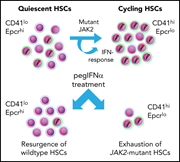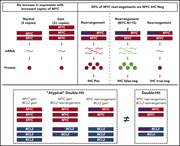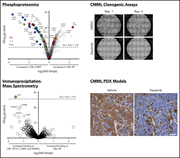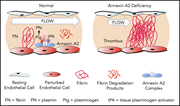Issue Archive
Table of Contents
BLOOD COMMENTARIES
PLENARY PAPER
JAK2-V617F and interferon-α induce megakaryocyte-biased stem cells characterized by decreased long-term functionality
There is renewed interest in the use of interferon-based therapy for patients with myeloproliferative neoplasms (MPNs). Using murine genetic models and primary patient samples, Rao et al demonstrate in a Plenary Paper how hematopoietic stem cell subpopulations contribute to MPN pathogenesis. They elucidate how pegylated interferon therapy perturbs these populations and provide a window to future prospects for altering the natural history of MPNs.
REVIEW ARTICLE
The pathobiology of thrombosis, microvascular disease, and hemorrhage in the myeloproliferative neoplasms
Hasselbach and colleagues review the integral relationship between the abnormal hematopoietic stem clone that causes MPNs, inflammation, and the thrombotic and hemorrhagic complications of these diseases. This is the second of a duet of papers on this topic, with the companion review on the clinical practicalities of managing of thrombotic complications of MPNs having been published in March.
CLINICAL TRIALS AND OBSERVATIONS
Combined oral 5-azacytidine and romidepsin are highly effective in patients with PTCL: a multicenter phase 2 study
Clinical Trials & Observations
Falchi and colleagues report on a potential future treatment for patients with peripheral T-cell lymphoma (PTCL) that targets the widespread epigenetic dysregulation characteristic of this disease. In a phase 2 study of 5-azacytidine and romidepsin in 25 patients, they document responses in 61% of patients, including complete responses in 48%, and provide preliminary evidence of associations between the likelihood of response and the presence of mutations in genes involved in DNA methylation and histone deacetylation.
IMMUNOBIOLOGY AND IMMUNOTHERAPY
LYMPHOID NEOPLASIA
Enhanced IL-9 secretion by p66Shc-deficient CLL cells modulates the chemokine landscape of the stromal microenvironment
Patrussi and colleagues describe a complex, interleukin-9 (IL-9)–dependent signaling pathway underlying the cross talk between chronic lymphocytic leukemia (CLL) and stroma cells, highlighting the exquisite dependency of leukemia cells on their microenvironment for survival and proliferation. They identify CLL-derived IL-9 as a niche-remodeling cytokine that generates a promigratory environment for tumor cells; antagonism of IL-9 in a murine model impairs pathogenicity. These data shine new light onto how to target CLL-mediated activation of stroma cells and may have therapeutic implications.
The impact of MYC and BCL2 structural variants in tumors of DLBCL morphology and mechanisms of false-negative MYC IHC
The optimal workflow to maximize accurate diagnosis of double-hit lymphoma (DHL) remains contentious. Through a comprehensive analysis of MYC and BCL2 structural variants among a cohort of 802 de novo tumors with diffuse large B-cell lymphoma morphology, Collinge et al rigorously demonstrate why immunohistochemistry (IHC) is not a good screen for MYC translocations. They also show that detection of copy number increases for MYC and BCL2 alone is insufficient to diagnose DHL.
MYELOID NEOPLASIA
CBL mutations drive PI3K/AKT signaling via increased interaction with LYN and PIK3R1
THROMBOSIS AND HEMOSTASIS
Reduced expression of annexin A2 is associated with impaired cell surface fibrinolysis and venous thromboembolism
Clinical Trials & Observations
Long-term outcomes with emicizumab prophylaxis for hemophilia A with or without FVIII inhibitors from the HAVEN 1-4 studies
Clinical Trials & Observations
Callaghan and colleagues provide a pooled data analysis of follow-up beyond 2 years for 4 trials of emicizumab in 401 patients with severe hemophilia A, with and without inhibitors. The data confirm the efficacy of this bispecific monoclonal antibody therapy, with rates of bleeding and factor usage dropping between weeks 24 and 120. They also confirm safety of the product over this longer-term exposure.
TRANSPLANTATION
VASCULAR BIOLOGY
Impaired adhesion of neutrophils expressing Slc44a2/HNA-3b to VWF protects against NETosis under venous shear rates
Inflammation is a critical component of venous thrombosis (VT). Previously, genomewide association studies (GWASs) have linked expression of the human neutrophil antigen 3b (HNA-3b) epitope on the Slc44a2 protein with a 30% decreased risk of VT. Zirka et al reveal that Slc44a2 expressing HNA-3a but not HNA-3b modulates neutrophil adhesion to von Willebrand factor, providing a plausible functional explanation for the GWAS observations and furthering the link between inflammation and VT.
LETTER TO BLOOD
B-cell acute lymphoblastic leukemia in patients with chronic lymphocytic leukemia treated with lenalidomide
Clinical Trials & Observations
BLOOD WORK
-
Cover Image
Cover Image
![issue cover]()
Fluorescently labeled neutrophil extracellular traps, showing total DNA (blue), histone H3cit (green), and myeloperoxidase (pink) after perfusion of primed neutrophils (1.5 × 106 cells per ml) at 100 s–1 in flow chambers. See the article by Zirka et al on page 2256.
- PDF Icon Front MatterFront Matter
- PDF Icon Table of ContentsTable of Contents
- PDF Icon Back MatterBack Matter
- PDF Icon Editorial BoardEditorial Board
Advertisement intended for health care professionals
Email alerts
Advertisement intended for health care professionals















“Interferon” with MPN hematopoietic stem cells